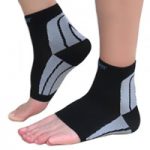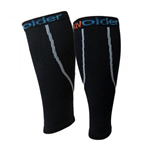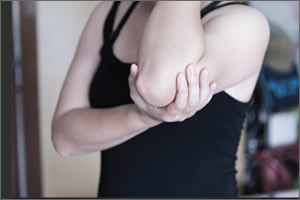Are your arm muscles sore after your exercise routine? Good. Because arm muscle soreness after exercise means your muscles are getting stronger. So don’t stop exercising; rather keep to your routine and put a pair of Uvoider Compression Arm Sleeves – More Support™ Series in your gym bag for wear both during and after exercise.
Muscle Soreness after Exercise
Whether you are just starting an exercise program for the first time or are a regular at the gym, muscle soreness after exercise is common and okay. When you use and stress your muscles, they will become sore. Sometimes the soreness and fatigue of a hard workout goes away quickly and other times they don’t. Referred to as Delayed Onset Muscle Soreness, or DOMS, muscle soreness after a workout can occur and be felt most strongly one to three days after your exercise. This is especially the case for crossfit and exercise newcomers after strenuously using muscle groups not normally or often used. Just a few sets of pullups can leave arms sore for days. And that’s okay.
How to Manage Muscle Soreness
So how do you manage muscle soreness? Is there a cure for muscle soreness? Physiologists all agree there is no cure for muscle soreness but there are measures that you can take to help the muscle recovery process. Here are a number of measures that can help you manage your muscle soreness:
Stretching
Simply put, people don’t stretch enough. Stretching is good to do before exercise, during exercise, and after exercise. Stretching promotes flexibility and good posture. And stretching not only strengthens your muscles but it helps to prevent injuries. When your muscles are stretched and warm, muscle movement is much easier, smoother and fluid-like. Conversely, muscles that are not regularly stretched can become stiff and prone to spasm.
Ice and Heat
Ice and heat can both be effective treatments for sore muscles. A few things to keep in mind. Heat is good for blood flow which is effective for reducing spasms, relieving stiffness, and relaxing tightened muscles. Applying heat to your sore muscles will relieve pain and soreness. Ice is good for muscles soreness as well, especially for reducing swelling. Many trainers advocate using ice for an injury and using heat for chronic muscle pain.
NSAIDs
NSAIDs are non-steroidal anti-inflammatory drugs such as aspirin, ibuprofen, and any number of over the counter products that you can buy at drug stores, grocery stores, and gas stations, just to name a few common places. NSAIDs relieve pain, lower fever, and reduce swelling. However, there are side effects and risks that you should be aware of. NSAIDs can cause nausea, vomiting, diarrhea, constipation, loss of appetite, rash, headaches, dizziness, and drowsiness. More serious side effects include kidney failure, liver failure, ulcers, and prolonged bleeding. NSAIDs can also cause the retention of lymph fluid which can lead to edema. Unless prescribed by a doctor or really needed, don’t make a habit out of taking NSAIDs.
Massage
Massage can be very good for sore muscles, but you have to use your judgment. Yes, a deep tissue massage is a great way to flush out the toxic waste that your muscles produce during a rigorous workout. But if you are recovering from an injury, take a pass on the deep tissue massage as it is likely to make your injury worse, not better. If you are just really sore, but not injured, go for a relaxation massage, aka a Swedish massage. This is a lighter massage that stimulates blood flow and lymph fluid circulation – excellent and safe treatment for sore muscles.
Cool-down
Overlooked by many is a good cool-down routine. A good cool-down routine is one of the most effective and safe ways to prevent muscle soreness. After a run, be sure to walk it off. After lifting weights, don’t forget to stretch. Many fitness trainers even recommend incorporating a cool-down training session as part of your weekly routine. This promotes blood flow and oxygen circulation which helps to recover, relieve, and strengthen sore muscles.
Compression
It is hard not to notice the take up in compression wear and for good reason. If you have sore muscles, compression can help. You can wear compression during your exercise and after to get the benefits of better blood flow, improved oxygenation, muscle support, pain relief and comfort. If you are a runner, compression calf sleeves will support your muscles and help you have a better run. If you are in the gym lifting weights or doing crossfit, compression arm and calf sleeves will support your muscle groups and keep you feeling fresh, relaxed, and ready to go. And after your run or workout, compression sleeves will help with muscle recovery.
Rest
Most people agree, the most effective treatment for sore muscles is resting your body and getting plenty of sleep. It is during sleep that the body produces the growth factors and hormones that recover and repair sore muscles. There is truth and medical support for the adage, no pain no gain. The process of muscle stress and muscle recovery is what leads to muscle strength and improved health and fitness. But listen to your body. If your body is telling you that you need to take a break or have a good night’s sleep, be sure to hear and comply.
For More Information on Sore Muscles
National Library of Medicine – Stretching to prevent muscle soreness
Mayo Foundation – Muscle Pain
WebMD – How to Manage Sore Muscles and Joint Pain
Uvoider Compression Foot Sleeves and Calf Sleeves – More Support Series (15-20 mmHg and 20-30 mmHg)
Uvoider UV Compression Foot Sleeves – More Support™ Series (20-30 mmHg

Uvoider UV Compression Calf Sleeves – More Support™ Series (15-20 mmHg and 20-30 mmHg


